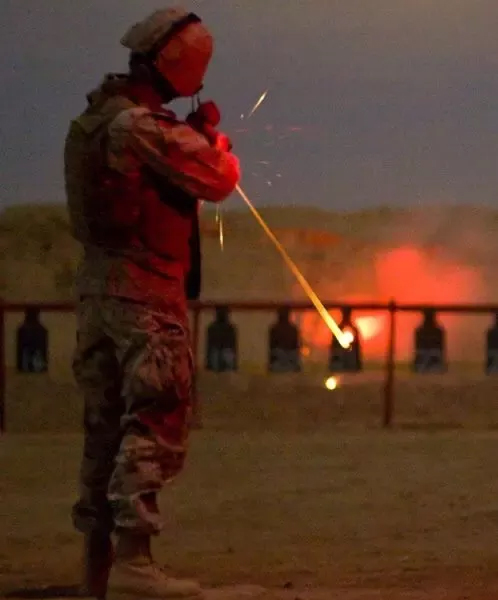


Free Shipping | 99% of all stands ship within 24 hours
We appreciate you sharing this:


We appreciate you sharing this:

Categories:
Competitive shooting sports have gained significant popularity in recent years, attracting both seasoned marksmen and enthusiastic beginners alike. These sports provide a platform for individuals to showcase their skills, accuracy, and precision with guns in a controlled and competitive environment. Among the various types of guns used in these competitions, the AR-15 rifle has emerged as a preferred choice due to its versatility, reliability, and widespread availability.
Competitive shooting sports encompass a wide range of disciplines that challenge shooters’ abilities in different ways. From precision long-range shooting to dynamic action shooting matches, these sports offer participants an opportunity to test their marksmanship skills under pressure. Competitors must demonstrate not only exceptional accuracy but also quick decision-making and adaptability. The AR-15 rifle has become particularly prominent within competitive shooting circles due to its unique features.
Originally designed for military use, the AR-15’s lightweight construction, ergonomic design, and customizable nature make it well-suited for various competitive shooting disciplines. Its semi-automatic firing mechanism allows for rapid follow-up shots while maintaining excellent control over recoil. Moreover, the AR-15’s modular design enables shooters to modify their rifles according to their specific needs and preferences. This adaptability allows competitors to fine-tune their guns with accessories such as optics, adjustable stocks, handguards, triggers, and more.
In this article series on the role of AR-15s in competitive shooting sports, we will explore how this particular gun has revolutionized these events.
The AR-15 rifle has become synonymous with competitive shooting sports, thanks to its versatility, accuracy, and reliability. Originally designed for military use, this semi-automatic gun has found its place in the world of competitive shooting due to its unique features and customizable nature. At its core, the AR-15 is a gas-operated rifle that fires intermediate cartridges. Its lightweight design makes it easy to handle and maneuver, allowing shooters to quickly acquire targets with precision.
The rifle’s ergonomic grip and adjustable stock provide comfort and stability during prolonged shooting sessions. One of the key advantages of the AR-15 is its modularity. Shooters can easily personalize their rifles by adding various accessories such as optics, handguards, grips, and muzzle devices. This customizability allows competitors to tailor their guns to meet specific shooting disciplines or personal preferences. In competitive shooting sports like 3-Gun or IPSC (International Practical Shooting Confederation), where speed and accuracy are paramount, the AR-15 excels.
Its semi-automatic action enables rapid follow-up shots without compromising accuracy. The rifle’s low recoil further aids in quick target acquisition and minimal disruption of sight picture. Moreover, the availability of different calibers for the AR-15 platform makes it suitable for a wide range of competitions. Shooters can choose from .223 Remington/5.56mm NATO for short-range matches or opt for larger calibers like .308 Winchester/7.62mm NATO for longer distances.
In conclusion, understanding the AR-15 rifle is essential when discussing its role in competitive shooting sports.
In the realm of competitive shooting sports, no other gun has achieved the level of dominance that the AR-15 has. Originally designed as a military rifle, the AR-15’s versatility, accuracy, and ease of customization have made it the weapon of choice for countless competitors across various shooting disciplines. One key factor contributing to the AR-15’s dominance is its inherent accuracy. The platform’s semi-automatic design allows for rapid follow-up shots while maintaining exceptional precision.
This is especially crucial in sports like Precision Rifle Series (PRS) matches or long-range shooting competitions where hitting targets with utmost accuracy at extended distances is paramount. The AR-15’s precise trigger pull and consistent barrel harmonics are highly advantageous when engaging multiple targets quickly or tackling challenging stages with tight time constraints. Furthermore, its modular nature allows shooters to modify and optimize their rifles to suit their specific needs and preferences.
Competitors can easily swap out barrels, handguards, triggers, stocks, and optics to enhance performance or adapt to different stages or disciplines. This adaptability grants shooters a significant advantage as they can fine-tune their guns to achieve superior ergonomics and maximize their personal shooting style. The availability of a wide range of accessories and aftermarket parts specifically designed for the AR-15 further solidifies its dominance in competitive shooting sports.
Shooters can select from an array of specialized components such as muzzle brakes, adjustable gas blocks, bipods, or extended magazine releases tailored to enhance performance in specific scenarios.
The AR-15 rifle has undergone a remarkable evolution in the realm of competitive shooting sports. Originally designed as a military gun, its adaptability and versatility have made it a popular choice among sports shooters. Over time, modifications and advancements have transformed the AR-15 into a highly specialized tool for precision shooting competitions. One significant aspect of the AR-15’s evolution is its improved ergonomics.
Manufacturers have introduced adjustable stocks and grips that allow shooters to personalize their weapon’s fit, enhancing comfort and control during extended shooting sessions. Additionally, advancements in lightweight materials have made these rifles more maneuverable, reducing shooter fatigue and increasing accuracy. Another crucial development in competitive shooting sports is the refinement of trigger mechanisms. Trigger pull weight has become an essential consideration for shooters seeking optimal accuracy.
Aftermarket triggers with adjustable weights enable competitors to fine-tune their rifle’s performance to meet their specific needs. These improvements have significantly enhanced trigger response times, resulting in greater precision during rapid-fire events. Optical enhancements have also played a vital role in shaping the AR-15’s evolution for sports shooting. The addition of high-quality optics such as holographic sights or magnified scopes allows competitors to acquire targets quickly and accurately at various distances.
These optics provide increased visibility, making it easier to track moving targets or identify smaller targets with greater precision. Furthermore, advancements in barrel technology have improved the rifle’s overall accuracy potential. Modern AR-15 barrels are often built with tighter tolerances and higher-quality materials, minimizing barrel harmonics and enhancing consistency shot after shot.
The AR-15 rifle has become increasingly popular in competitive shooting sports due to its numerous advantages. This versatile gun offers several benefits that contribute to enhanced performance, accuracy, and overall shooting experience for competitors. Firstly, the modular design of the AR-15 allows shooters to customize their rifles according to their specific needs and preferences. The wide range of aftermarket accessories available ensures that competitors can optimize their gun’s ergonomics, weight distribution, and overall balance.
By tailoring their AR-15s to fit their shooting style, competitors can achieve better control and faster target acquisition. Another significant advantage is the inherent accuracy of the AR-15 platform. The rifle’s semi-automatic action combined with its straight-line recoil design minimizes muzzle rise and allows for quick follow-up shots with minimal disturbance to sight picture. This characteristic is crucial in competitive shooting sports where speed and precision are paramount.
Furthermore, the availability of different calibers compatible with the AR-15 platform gives shooters flexibility based on competition requirements or personal preference. Competitors can choose from various chamberings such as .223 Remington or 6.5mm Grendel, offering different ballistic characteristics suitable for different disciplines or distances. Additionally, the popularity of the AR-15 means that ammunition is widely accessible and affordable compared to other less common guns used in competitive shooting sports.
The ease of finding compatible magazines also contributes to an uninterrupted flow during matches without worrying about reloading frequently.
Competitive shooting sports involving AR-15 rifles require strict adherence to safety measures and regulations to ensure the well-being of participants and spectators. These guidelines are designed to minimize the risk of accidents, promote responsible gun handling, and maintain a safe environment for all involved. Firstly, all participants must undergo comprehensive safety training before being allowed to compete. This training covers essential topics such as proper gun handling, range etiquette, and emergency procedures.
Competitors must demonstrate proficiency in these areas before being granted access to any shooting event. In addition, range officers play a vital role in maintaining safety during competitive shoots. They are responsible for enforcing rules and regulations, ensuring that shooters follow proper gun protocols, and immediately addressing any safety concerns that may arise. Range officers have the authority to stop a shooter or disqualify them if they observe unsafe behavior or rule violations.
Furthermore, strict equipment regulations are put in place to prevent accidents. AR-15 rifles used in competitive shooting must comply with specific specifications regarding barrel length, caliber restrictions, trigger pull weight limits, and other factors that affect performance. These regulations ensure fairness among competitors while also prioritizing safety. Another crucial aspect of competitive shooting safety is the use of appropriate personal protective equipment (PPE).
Shooters are required to wear eye protection and hearing protection at all times during events. This helps protect against potential injuries caused by ejected casings or loud gunshot noises. Overall, maintaining a safe environment in competitive shooting sports with AR-15s is paramount.
To excel in competitive shooting sports, athletes must undergo rigorous training and skill development with their chosen weapon. The AR-15 rifle has gained immense popularity among competitors due to its versatility, accuracy, and ease of customization. Training with the AR-15 rifle is crucial for honing marksmanship skills and achieving peak performance in various shooting disciplines. One fundamental aspect of training with the AR-15 rifle is mastering the basics of marksmanship.
Competitors focus on developing skills such as proper grip, sight alignment, trigger control, breathing techniques, and follow-through. These foundational elements form the basis for consistent accuracy and precision in shooting. The AR-15’s modular design allows shooters to customize their rifles according to their specific needs. This customization extends to various accessories such as optics, stocks, grips, triggers, and muzzle devices. Competitors spend considerable time experimenting with different configurations to find what works best for them individually.
Competitive shooters also engage in regular dry-fire practice sessions to enhance their shooting skills without live ammunition. Dry-fire exercises help develop muscle memory, refine trigger control techniques, improve sight picture acquisition speed, and enhance overall gun manipulation proficiency. Furthermore, competitors participate in live-fire training sessions where they practice engaging targets at varying distances under simulated match conditions. These sessions emphasize speed drills combined with accuracy requirements to replicate real-world scenarios encountered during competitions.
As one of the most popular rifles in competitive shooting sports, the AR-15 has firmly established its dominance on the range. However, with evolving technologies and changing regulations, the future of this iconic gun in competitive shooting is a topic of much discussion and speculation. One key aspect that will shape the future of AR-15s in competitive shooting is advancements in rifle design.
Manufacturers are constantly striving to improve accuracy, ergonomics, and overall performance. With new materials and manufacturing techniques emerging, we can expect to see lighter and more durable AR-15 variants that cater specifically to competitive shooters. These innovations will undoubtedly enhance shooters’ abilities and potentially redefine the standards for excellence. Additionally, regulations surrounding guns are subject to change over time. While the AR-15 has faced scrutiny due to its military origins, it remains a staple in many shooting disciplines today.
However, as laws evolve, it is crucial for competitive shooters to stay informed and adaptable. The future might bring forth stricter regulations or modifications specific to competition shooting events that could influence how AR-15s are used. Furthermore, technological advancements outside of rifle design may also impact the future role of AR-15s in competitive shooting sports. For instance, improvements in optics and sighting systems can greatly enhance shooter accuracy at various distances.
The integration of smart technology into guns could also revolutionize training methods and data analysis for competitors.